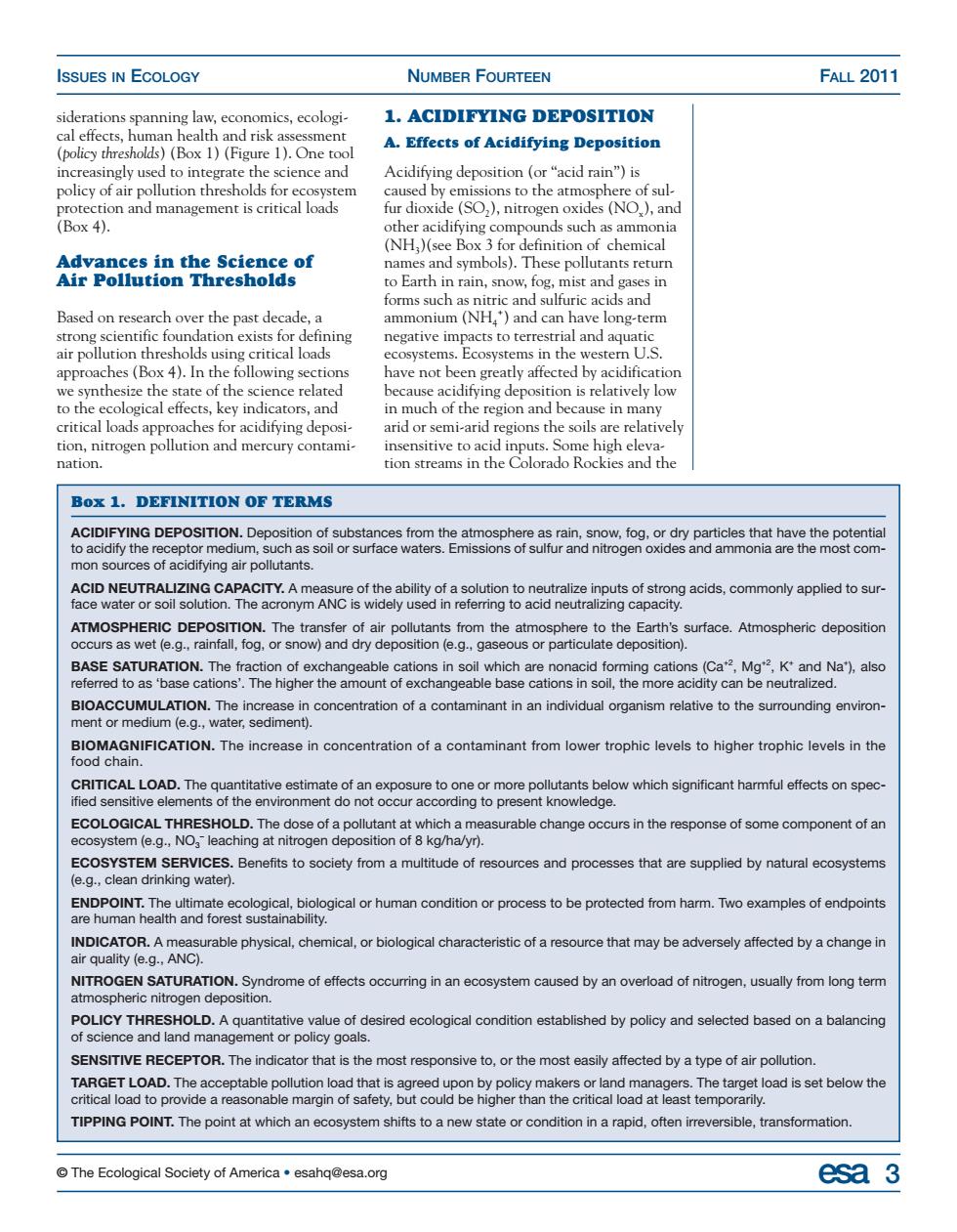正在加载图片...

ISSUES IN ECOLOGY NUMBER FOURTEEN FALL 2011 ,ecologi 1.ACIDIFYING DEPOSITION sment A.Effects of Acidifying Deposition fur dix (),oe(N)n Advances in the Science of Air Pollution Thresholds to Earth in rain,snow,fog,mist and gases in Based on researchc fomsaucha5nitrcandslfrtcacidsand negative impa ts to te estrial and air pollution thre ecosystems.Ecosystems in the westemn U.S approaches (B in much of the reion and ecause in n arid or semi-arid regions the soils are relatively stre Box 1.DEFINITION OF TERMS mon sources of acidifving air pollutants ability applied to su ccurs as wet (e.g.,rainfall,fog,or snow)and dry deposition(e.g.,gaseous or parti deposition) nant in an relative to the surrounding environ ohic levels in the CRITICAL LOAD.The quantitative estimate of an exposure to one or more pollutants below which significant harmful effects on spec. ied sensitive elements vironment do not occur according neasurable change occurs in the resp se of some component of ar iety from a multitude of re ural ecosystems sof endpoints ay be adversely affected by a change i ne of effects occurring in an ec ed by an overload of nitrogen,usually from long term desired ecologic conditi olished by policy and selected basedon a balancing SENSITIVE RECEPTOR.The indicator that sthem ve to,or the ed by a tyr TIPPINGPOINT.The point at which an ecosystem shifts to a new state or condition in a rapid,often irreversible, The Ecological Society of America.esahg@esa.ord esa 3© The Ecological Society of America • esahq@esa.org esa 3 ISSUES IN ECOLOGY NUMBER FOURTEEN FALL 2011 siderations spanning law, economics, ecological effects, human health and risk assessment (policy thresholds) (Box 1) (Figure 1). One tool increasingly used to integrate the science and policy of air pollution thresholds for ecosystem protection and management is critical loads (Box 4). Advances in the Science of Air Pollution Thresholds Based on research over the past decade, a strong scientific foundation exists for defining air pollution thresholds using critical loads approaches (Box 4). In the following sections we synthesize the state of the science related to the ecological effects, key indicators, and critical loads approaches for acidifying deposition, nitrogen pollution and mercury contamination. 1. ACIDIFYING DEPOSITION A. Effects of Acidifying Deposition Acidifying deposition (or “acid rain”) is caused by emissions to the atmosphere of sulfur dioxide (SO2), nitrogen oxides (NOx), and other acidifying compounds such as ammonia (NH3)(see Box 3 for definition of chemical names and symbols). These pollutants return to Earth in rain, snow, fog, mist and gases in forms such as nitric and sulfuric acids and ammonium (NH4 + ) and can have long-term negative impacts to terrestrial and aquatic ecosystems. Ecosystems in the western U.S. have not been greatly affected by acidification because acidifying deposition is relatively low in much of the region and because in many arid or semi-arid regions the soils are relatively insensitive to acid inputs. Some high elevation streams in the Colorado Rockies and the Box 1. DEFINITION OF TERMS ACIDIFYING DEPOSITION. Deposition of substances from the atmosphere as rain, snow, fog, or dry particles that have the potential to acidify the receptor medium, such as soil or surface waters. Emissions of sulfur and nitrogen oxides and ammonia are the most common sources of acidifying air pollutants. ACID NEUTRALIZING CAPACITY. A measure of the ability of a solution to neutralize inputs of strong acids, commonly applied to surface water or soil solution. The acronym ANC is widely used in referring to acid neutralizing capacity. ATMOSPHERIC DEPOSITION. The transfer of air pollutants from the atmosphere to the Earth’s surface. Atmospheric deposition occurs as wet (e.g., rainfall, fog, or snow) and dry deposition (e.g., gaseous or particulate deposition). BASE SATURATION. The fraction of exchangeable cations in soil which are nonacid forming cations (Ca+2, Mg+2, K+ and Na+ ), also referred to as ‘base cations’. The higher the amount of exchangeable base cations in soil, the more acidity can be neutralized. BIOACCUMULATION. The increase in concentration of a contaminant in an individual organism relative to the surrounding environment or medium (e.g., water, sediment). BIOMAGNIFICATION. The increase in concentration of a contaminant from lower trophic levels to higher trophic levels in the food chain. CRITICAL LOAD. The quantitative estimate of an exposure to one or more pollutants below which significant harmful effects on specified sensitive elements of the environment do not occur according to present knowledge. ECOLOGICAL THRESHOLD. The dose of a pollutant at which a measurable change occurs in the response of some component of an ecosystem (e.g., NO3 – leaching at nitrogen deposition of 8 kg/ha/yr). ECOSYSTEM SERVICES. Benefits to society from a multitude of resources and processes that are supplied by natural ecosystems (e.g., clean drinking water). ENDPOINT. The ultimate ecological, biological or human condition or process to be protected from harm. Two examples of endpoints are human health and forest sustainability. INDICATOR. A measurable physical, chemical, or biological characteristic of a resource that may be adversely affected by a change in air quality (e.g., ANC). NITROGEN SATURATION. Syndrome of effects occurring in an ecosystem caused by an overload of nitrogen, usually from long term atmospheric nitrogen deposition. POLICY THRESHOLD. A quantitative value of desired ecological condition established by policy and selected based on a balancing of science and land management or policy goals. SENSITIVE RECEPTOR. The indicator that is the most responsive to, or the most easily affected by a type of air pollution. TARGET LOAD. The acceptable pollution load that is agreed upon by policy makers or land managers. The target load is set below the critical load to provide a reasonable margin of safety, but could be higher than the critical load at least temporarily. TIPPING POINT. The point at which an ecosystem shifts to a new state or condition in a rapid, often irreversible, transformation